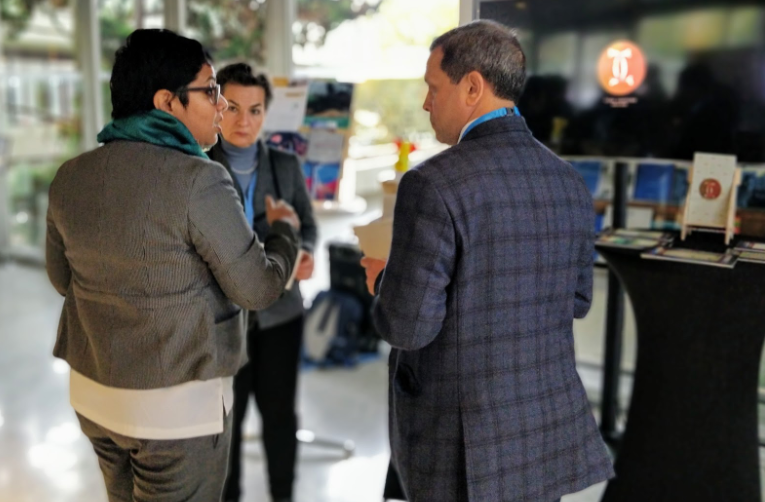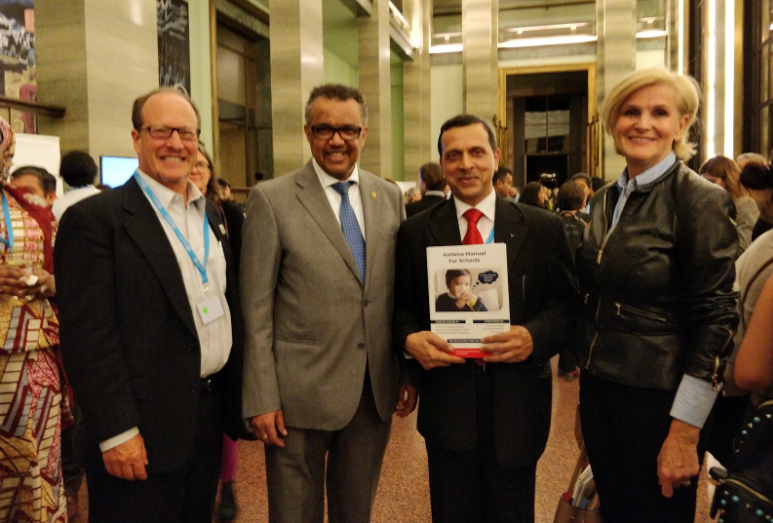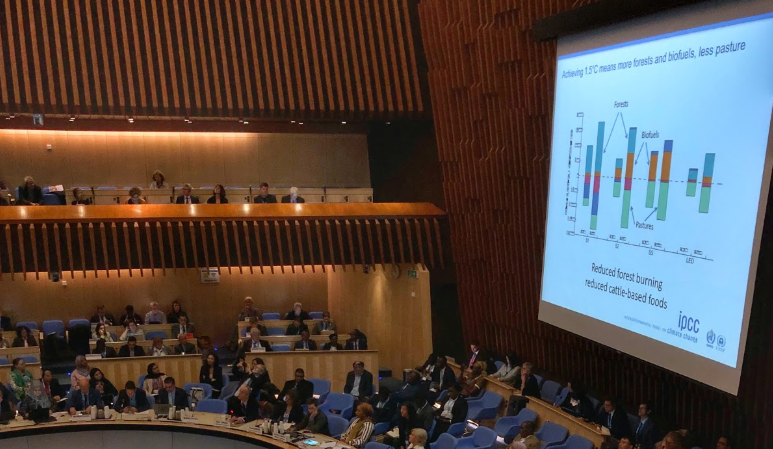From Evidence to Advocacy at the WHO Air Pollution Conference Days 1 and 2
1 November 2018, Geneva
By Viktor Jósa (Europe Climate Policy & Projects Officer) and Jennifer Wang (Healthy Energy Initiative Coordinator), Health Care Without Harm

Shweta Narayan (Healthy Energy Initiative India Coordinator) showing Dr. Arvind Kumar and Christiana Figueres (Mission 2020 Convenor and former head of the UNFCCC) ‘Coal Couture’, a Health Care Without Harm-commissioned art installation by Indian artist Baaraan Ijlal, which tells the stories of children whose lives are affected by pollution from coal plants and coal mines in India, the Philippines, and South Africa. Figueres and Kumar are two of the clean air champions of the newly launched Every Breath Matters campaign.
Take a deep breath. Are you breathing safe air? Some 91% of people worldwide breathe unhealthy air, and the time to act was yesterday. But a broad coalition of WHO and other UN agencies, Ministries of Health and Environment, civil society, and researchers are raising the level of ambition and building a global movement for clean air. These were the messages being echoed from different angles during the first two days of the First WHO Global Conference on Air Pollution and Health. The atmosphere in the WHO HQ in Geneva was filled with synergies, linkages and solutions to address air pollution, the biggest environmental health risk, and climate change, the greatest public health threat of the 21st century. You can exhale now - we start making a change!
Doctors as active advocates for clean air
One of the most rousing moments of the conference has been the speech by Health Care Without Harm partner Dr. Arvind Kumar, a distinguished thoracic surgeon at Sir Ganga Ram Hospital in New Delhi and Founder & Trustee of Lung Care Foundation in India. Dr. Kumar gave a sobering account of seeing lung cancer in younger and younger age groups, and operating on non-smokers with lungs as blackened as those of lifelong smokers. He then shared a series of success stories of doctors advocating for clean air--by communicating the health effects of air pollution widely through the media, engaging the most vulnerable populations like children, and building the health case for action to policymakers. Responding to his call for “action, action, and more action,” participants responded with one of the longest ovations of the conference, and several subsequent speakers alluded to his impassioned vision.
Dr. Kumar is among a group of clean air champions that are spearheading Every Breath Matters, a new campaign to raise awareness about the devastating health impacts of air pollution and push world leaders to take bold action that will clean up the air and protect the health of billions of people.

Josh Karliner (Health Care Without Harm International Co-Director, far left) with Dr. Arvind Kumar (Lung Care Foundation Founder, third from left), presenting his Asthma Manual for Schools to Dr. Tedros Adhanom Ghebreyesus (WHO Director General) and Dr. Maria Neira (WHO Director, Public Health, Environmental and Social Determinants of Health).
Healthy air, healthy climate in the UNFCCC process
The UN system strives to connect its conventions and processes, which is evident in WHO’s recent efforts linking the UNFCCC and the upcoming COP24 to the global health agenda. Currently there is a WHO COP24 Special Report in the making on health and climate change, which is inclusive by its nature seeking public input through consultation. This report was targeted by an early afternoon side-event on Day 1, where non-state stakeholders from different NGOs and academic institutions gathered in a tiny room with WHO staff over one cup of unbreathed air each to discuss recommendations. It’s always delighting to see an old-fashioned bureaucratic entity seeking innovative approaches to improve its impact, and this session was concluded by calling for possible ways to link the COP24 Report on health and climate change with the UNFCCC policy/negotiation process, rather than just let it circle with all the previously published reports like a scientific debris around the UNFCCC orbit. The recommendations from the public consultation with non-state actors consist of aspects, which are key when addressing health, air pollution and climate change interlinkebly. Co-benefits of financing, monitoring and mitigating emissions come hand-in-hand with health gains and health care savings in which, the advocacy of the health community, including civil society is playing a central role. The high number of non-state actors participating in the conference and their inputs provided in the side-events and parallel sessions were noted to be fed into the recommendations of the COP24 Report on health and climate change.
The Geneva mission
The approach of Health Care Without Harm in the air pollution discussion stays true to the organization’s name and the Hippocratic Oath of doing no harm and reducing health care’s contribution to the underlying problem through deploying and purchasing clean and healthy energy. Our intervention inputs by Josh Karliner during parallel sessions on Days 1 and 2 around actions with health focus sensitized the growing global movement for 100% renewable electricity in health care facilities. Given the regional approach of HCWH, we are driving RE efforts also in Europe and will be showcasing European hospitals and health systems in an upcoming webinar on November 6. The main principles around scaling renewable energy in health care in multiple settings across developed and developing countries are morally imperative and economically viable. Implementing renewable energy or using electricity from renewable sources in health care aligns with the sector’s mission to prevent disease and to heal by eliminating ambient air pollution around health care facilities and mitigating the use and reliance on fossil fuels. Such measures are fostering increased access to care and greater health equity in off-the-grid and grid unstable settings. The climate-smart approach demonstrated and promoted by our network allows health care facilities in all settings to be more resilient by helping keep the lights on in extreme weather events and emergency situations and it proves to be increasingly economically viable and affordable. Health care costs can be reduced by investing in and transitioning to renewable energy thereby driving national policies to subsidize the wider use of clean and healthy energy.

The Executive Board Room at the WHO Headquarters in Geneva.
Motivation concentration and recreation in the UN atmosphere
The opening day culminated with a generous pescatarian reception, which is also great progress for the UN on mitigating emissions in its own household. The UN atmosphere always delivers when it comes to creating an inspiring event, which connects people and initiatives for good. For delegations to the UN a conference day is over full-time, because the magical partnerships and initiatives happen during the informal moments and not at the discussion table. The diverse and multicultural UN atmosphere always delivers some recreation beyond the science and policy and Wednesday’s evening time was locked in for the BreatheLife live concert with Grammy award winner Ricky Kej and World Music Ensemble in the Geneva UN Palace. The environment inspired visual and musical performance and the engagement of the audience in signing together the new Earth Song was touching and it seeked to encourage participants in committing to bold action. The HCWH delegation is grateful for the opportunity and is looking forward to help treat the air pollution disease with all actors on board. Our next blog post will cover the final day of the conference: the High Level Action Day, in which Health Care Without Harm and dozens of other delegations will announce commitments to ambitious action for clean air.
More news and updates from the conference
